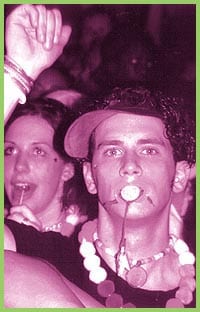One tasty, precise section in Mireille Silcott’s fast paced book Rave America maps the connection among peace, love, happiness, hippies and ravers.
Ecstasy use in the 1980s, a holdover from ’60s MDMA, was rampant in the emerging New Age movement in Texas, of all places. The whale lovers took the drug with them when they holidayed in the Spanish island resort, Ibiza – a town populated by hippie artisans and jet-setting club all-stars. According to Silcott, the hippies brought the ecstasy, the clubbers brought the new, edgy House music… and the rest is history.
This connecting-the-dots in the early chapters is priceless. Silcott maps the coining of the term raver, the birth of House music and the homophobia and racism thinly disguised in the “Disco Sucks” backlash.
But her crisp style breaks down badly in the Toronto chapter. She chooses to contextualize her description of the local scene with unfortunate comments about our general lack of character: “A pretty wish-washy number,” she calls it. While Montreal-based writer recognizes that Toronto still musters the largest and liveliest rave scene on the continent, she characterizes it as ingenuine, a slavish copycat to the UK, and one that, from the start, was created by suburban kids from Brampton.
As a minor enthusiast myself of the scene in the early ’90s, I remember lying three or four deep with strung out high school boys and girls from the suburbs on weekends at 23 Hop. But I also remember – vaguely – attending raves where the washrooms were a broken warehouse elevator shaft guarded only with yellow tape. The grittier, more urban side of the Toronto rave scene is absent from Rave America.
Silcott’s style also runs hot and cold in the chapter on circuit parties. Silcott starts out accurately mapping the differences between counter culture raves and the circuit’s business-sponsored, mega-buck fundraisers. But a tone of sympathy – or even pathos – enters as she surrenders three pages to one circuit queen’s personal account of bare-backing, rumoured to be rampant in the scene.
From the opening chapters, Silcott has established herself as strongly anti-homophobic, so these tangential issues are a little out of character with the rest of the book.
In overview, Silcott identifies a two-year pattern for most every rave scene, in which the good good feelings eventually lose their shine usually due to the drugs: “Like the rave scene,” she writes, “the circuit didn’t originate as a place of excess. Escape, maybe, but not excess. But like the rave scene, after a couple of years the circuit became a place of excess. I’m not tut-tutting the trajectory: I’m just calling it inevitable…. Like every other rave scene in the world, the [North] American rave scene was, for the most part, fractured by excess.
Rave America.
By Mireille Silcott.
ECW Press.
$26.50.

 Why you can trust Xtra
Why you can trust Xtra


